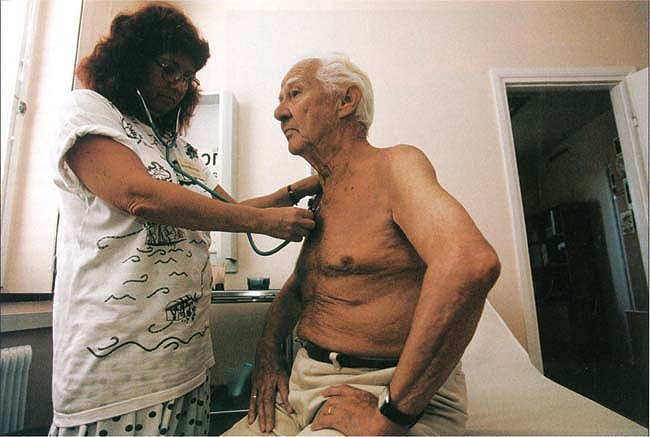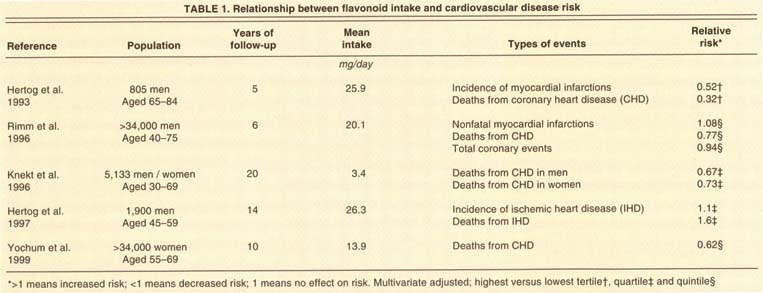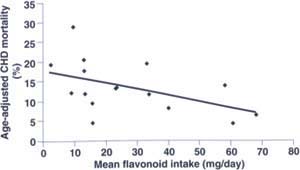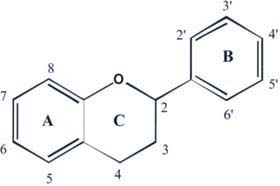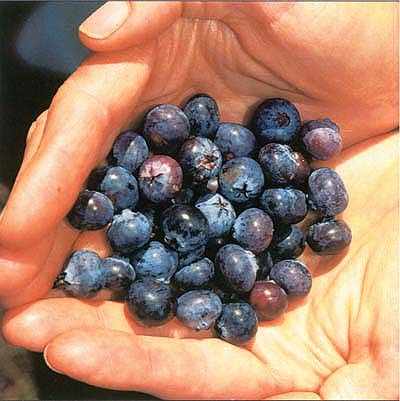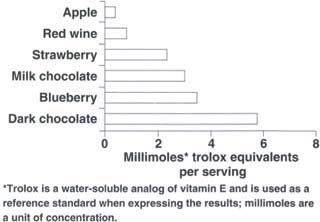All Issues
Dietary flavonoids may promote health, prevent heart disease
Publication Information
California Agriculture 54(5):33-39. https://doi.org/10.3733/ca.v054n05p33
Published September 01, 2000
PDF | Citation | Permissions
Abstract
Nutrients exert measurable effects on biological processes and are among many factors that optimize health by helping to prevent, cure, treat or slow the progression of chronic diseases. Certain plant components (i.e., phytochemicals) may not be considered essential by traditional measures, but are increasingly recognized for their beneficial health effects. In particular, dietary flavonoids may make an important contribution to cardiovascular health. Epidemiological studies have shown that intake of flavonoids may be inversely associated with long-term mortality from coronary heart disease in epidemiological studies. Research with flavonoid-rich foods such as red wine, tea, blueberries and chocolate has demonstrated their antioxidant capacity. However, different flavonoids appear to have varying degrees of effect (e.g., inhibiting the oxidation of low-density lipoprotein cholesterol) and most of the flavonoid research has been limited to a few simple flavonoids, rather than a comprehensive investigation of all flavonoids present in the diet or a particular foodstuff. Well-controlled clinical studies are needed to determine whether flavonoids offer true benefits to cardiovascular health and to understand other potential mechanisms, in addition to antioxidant activity, which may be responsible for their protective action.
Full text
Flavonoids inhibit the oxidation of lipoprotein cholesterol, lowering the risk of cardiovascular disease.e
Classically, a nutrient is defined as a component of food essential for normal growth and development that cannot be made by the body in sufficient quantities. Recently, a new dimension has been added to the traditional view of nutrients: nutrients exert measurable effects on biological processes and are among many factors that optimize health by helping to prevent, cure, treat or slow the progression of chronic diseases.
With this paradigm shift comes a whole different set of questions about the active components in diet and foods. In particular, components of plant origin (i.e., phytochemicals) may not be considered essential by traditional measures, but are increasingly recognized for their beneficial effects on health promotion and disease prevention.
Processing, such as enological practices in winemaking, can affect the flavonoid levels in antioxidant-rich foods such as red wine. At Ferrari-Carano Winery in Healdsburg, a cellerman tops off barrels of zinfandel.
Fig. 1. Flavonoid intake and risk of coronary heart disease (CHD)/mortality. Source: Hertog et al. 1995.
In 1936, Rusznyàk and Szent-Györgyi reported that consumption of some flavonoids, a subclass of polyphenols present in most plant species, decreased the capillary permeability and fragility seen in people with scurvy and stabilized or increased the biological activity of ascorbic acid (vitamin C). This report gave rise to the concept that polyphenols may have vitamin action and coined the term vitamin P. Soon after, doubts about the evidence for these claims arose. In 1950, flavonoids were stripped of their vitamin status because the concept that they are essential food components equivalent to vitamins was not fully substantiated. However, in recent years many observations have indicated that dietary flavonoids make an important contribution to health, particularly to heart health and the cardiovascular system.
Population studies
A growing body of research suggests that excessive oxidation plays a significant role in the pathogenesis of atherosclerosis, a disease in which fatty deposits and lesions form in the arteries. This excessive oxidation can be caused by free radicals, which are highly reactive chemical species capable of causing damage to DNA and molecules important for blood vessel health (e.g., certain proteins, fatty acids, lipoproteins and cholesterol).
Interest in dietary flavonoids has resurged because their antioxidant properties suggest a protective role in protecting against chronic disease. For example, the low incidence of heart disease among the French is considered a paradox because their diets are rich in saturated fat, but has been attributed in part to high intake of flavonoids in red wine (Renaud and de Lorgeril 1992). Indeed, flavonoid consumption has been inversely associated with long-term mortality from coronary heart disease when different population groups with a wide range of flavonoid intakes are examined (fig. 1).
The hypothesis that flavonoids may help prevent heart disease received a boost in 1993 when Hertog et al. reported an inverse association between the intake of five flavonoids (quercetin, kaempferol, myricetin, luteolin and apigenin) and mortality from coronary heart disease in men in the Netherlands. However, subsequent epidemiological studies on the association between flavonoid intake and cardiovascular disease have produced equivocal results (table 1).
In 1996, Rimm and co-workers observed no association between flavonoid intake and incidence of nonfatal myocardial infarctions, which is similar to the results that Hertog and co-workers found in 1997. However, there are discrepancies in the correlation of flavonoid intake and risk of death from heart disease. Rimm and co-workers (1996) found that an inverse correlation between flavonoid intake and risk of death from coronary heart disease was limited to the men who had previously had cardiovascular disease (relative risk 0.63), but was still not statistically significant. Similarly, Yochum et al. (1999) and Knekt et al. (1996) observed a trend for an inverse correlation between flavonoid intake and coronary heart disease mortality. In contrast, Hertog and coworkers (1997) found that flavonoid intake had no effect on the number of incidences of heart disease but had a mild positive correlation to mortality.
To date, epidemiological data do not support a strong inverse association between the intake of flavonoids and heart disease, but they do not exclude the possibility that flavonoids have a protective effect. Although these studies try to correct for other confounding factors such as age, diet and smoking habits, the confounders are measured with less than perfect precision and cannot be completely eliminated by multivariate analysis. Furthermore, most epidemiological studies to date have focused primarily on the same five flavonoids. In reality, more than 4,000 structurally different flavonoids have been identified. The use of select flavonoids to infer epidemiological relationships to health and disease could also be confounded by the fact that different flavonoids may exhibit varying physiological effects.
More than 4,000 structurally different flavonoids have been identified, although most epidemiological studies have focused on just five. Black tea contains high levels of flavanols, a class of flavonoids.
Flavonoid attributes
Flavonoids are diphenylpropanes, containing a number of phenolic hydroxyl groups attached to the characteristic 15-carbon backbone ring structure (C6-C3-C6) (fig. 2). The subclasses of the flavonoids are categorized by the structure of the C-ring and are generally distinguished based on the presence or absence of a 2,3 double bond, 3-hydroxyl group, and/or a 4-oxo group (table 2). Within a subclass, individual differences result from the variation in number and arrangement of the hydroxyl groups (-OH) on the A and B rings, as well as the nature and extent that they are substituted (for example, sugar).
Although it has been known for some time that flavonoids are essentially ubiquitous in the plant kingdom, scientists have only recently begun to study them in foods. Unfortunately, detailed information on the flavonoid profiles present in many food products is lacking. Not surprisingly, the types and quantities of flavonoids found in different plant-derived foods vary considerably (table 2).
In addition to variation between foods, there is significant variation within a food, because these compounds are secondary metabolites produced by the plant in response to various environmental stimuli such as sun, insect bites, infections and so on. Postharvest practices, processing and cooking can also have a significant impact on flavonoid content. For example, large variations in red wine flavonoid concentrations have been reported and attributed to aging, geographical location, enological practices, types of red wine and fining (a treatment, usually with protein, for clarifying or preventing solids from settling). With such large variations possible, extensive sampling would be required to compile a comprehensive database of foods and beverages containing flavonoids. Because these compounds have influenced health in clinical and in vitro studies, this compositional data could be important in food consumption surveys to define intake levels and determine whether epidemiological associations with health and disease endpoints are present.
Potential mechanisms
Antioxidant activity.
The mechanism for the apparent protective action of flavonoids is currently the subject of considerable research. One area of focus has been their antioxidant properties, which are largely governed by structural characteristics. Flavonoids can act as antioxidants by several mechanisms, including donating hydrogen, quenching singlet oxygen, scavenging free radicals and chelating redox active metals. Numerous assays have been developed to investigate antioxidant potential, most of which reflect the ability of the flavonoid or food to scavenge a free radical. The antioxidant capacity of individual flavonoids as measured by these assays generally correlates to their reduction potential and the number of hydroxyl groups present.
Investigations into the antioxidant capacity of flavonoid-rich foods have demonstrated that antioxidant capacity, as measured using the oxygen radical absorbance capacity (ORAC) assay, increases with increasing amounts of flavonoids present (fig. 3). For example, Prior et al. (1998) showed a correlation between anthocyanin content in different blueberry species and their antioxidant capacity. Similarly, Adamson et al. (1999) demonstrated a strong relationship between the procyanidin content in cocoa and chocolate samples and their antioxidant capacity.
Since it is generally accepted that flavonoids are antioxidants by virtue of their structural features, much research has focused on determining whether consuming these compounds can increase the antioxidant activity of blood serum. Whitehead et al. (1995) demonstrated that 300 milliliters (approximately 3 glasses of wine) of red wine, but not white wine, significantly increased serum antioxidant capacity post-consumption. The effect seen was similar to that observed for supplementation with 1,000 milligrams of ascorbic acid. One explanation for the differences seen between red and white wine could be the flavonoid content, which is generally higher in red wine.
To test the concept that increased serum antioxidant capacity is due to the flavonoids, Wang et al. (2000) performed a clinical study with increasing doses of chocolate known to contain relatively high amounts of these phytochemicals. In this study, the more chocolate the subjects consumed, the greater the quantities of the flavonoid epicatechin were found in their blood plasma, with a corresponding trend of increased antioxidant capacity. The study suggested that the changes in antioxidant capacity may be due to the epicatechin circulating in the blood.
Nonetheless, caution is necessary when interpreting the data because the biological implications of such measures are not yet clear. Furthermore, the role of oxidative damage as a primary cause of cardiovascular disease has been questioned by some investigators, as has the hypothesis that antioxidants in the diet can reduce its onset and progression. It is possible that dietary flavonoids have cardio-protective factors that are in addition to antioxidants.
Inhibition of LDL oxidation.
The oxidative modification of low-density lipoprotein (LDL) cholesterol (“bad” cholesterol) is widely recognized as playing a pivotal role in the formation of lesions in the artery and the subsequent development of atherosclerosis. Indeed, the susceptibility of LDL to oxidation may be a biomarker for the presence, severity and progression of the disease. Researchers have focused on the potential role of flavonoids in preventing LDL oxidation, thereby preventing or slowing the atherosclerotic process.
Numerous flavonoids and flavonoid-rich foods have been studied for their potential to inhibit LDL oxidation and exert cardioprotective effects. A variety of flavonoids such as those found in chocolate, known as procyanidins (Bearden et al. 2000), and flavonoid-rich foods such as red wine (Frankel et al. 1995), protected LDL from oxidation following their in vitro addition to oxidizing systems. However, data concerning protection against LDL oxidation following consumption of flavonoid-rich foods has been inconsistent.
Researchers have shown a relationship between anthocyanin levels in blueberries and their antioxidant capacity.
For example, Kondo et al. (1996) demonstrated that LDL collected from subjects 2 hours after consumption of 35 grams of defatted cocoa was more resistant to oxidation than LDL obtained from the same subjects prior to ingestion of the cocoa. In contrast, studies investigating the impact of tea consumption on the oxidative susceptibility of LDL have shown no effect (van het Hof et al. 1999).
Importantly, different flavonoids appear to inhibit LDL oxidation to varying degrees. Bearden et al. (2000) found that the more flavonoid units linked together in procyanidin oligomers found in cocoa, the greater the ability to inhibit LDL oxidation in vitro. Since it is known that certain chocolates are rich in procyanidin oli-gomers, whereas tea is rich in single flavonoid compounds, this may explain the differences seen after eating these foods.
Platelet activation and aggregation.
Blood platelets play a major role in cardiovascular disease and thrombosis (a blood clot in a blood vessel or cavity of the heart). Preventive antithrombotic treatments include platelet inhibitors such as aspirin, and perhaps antioxidants. Indeed, excessive platelet aggregation has been identified as a potential risk factor for cardiovascular disease. In this regard, flavonoids may affect thrombosis and cardiovascular disease by interfering with platelet activation and function.
Scientists have demonstrated extensively that flavonoids can inhibit platelet aggregation in vitro. For example, Tzeng et al. (1991) demonstrated that pure flavonoid compounds were antiaggregatory because they inhibited thromboxane formation, which is the same mechanism responsible for the effects of aspirin. Other research has attributed the antiaggregatory effects of flavonoids to their ability to increase platelet cAMP, which plays an important role in the control of platelet aggregation.
Fig. 3. Comparison of antioxidant activities. Sources: Adamson et al. 1999; Ghiselli et al. 1998; Prior et al. 1998; Wang et al. 1996.
Research subjects who consumed greater “doses” of chocolate showed higher levels of the flavonoid epicatechin in their blood plasma.
The ability of flavonoids to inhibit platelet aggregation has also been demonstrated post-consumption of flavonoid-rich foods such as red wine, purple grape juice and cocoa. In a recent clinical study, scientists investigated the effects of a high-flavonoid cocoa beverage on markers of platelet activation and function (Rein et al. 2000). After the beverage was consumed, decreased levels of receptors were expressed on the surface of the platelets. These receptors are associated with platelet-blood vessel interactions and platelet-platelet aggregation.
This observation was further strengthened by looking at platelet-related primary hemostasis, which is a measure of the time it takes for the blood to clot. Following consumption of the cocoa beverage, it took longer for the subjects' blood to clot than prior to consumption. Therefore consumption of a flavonoid-rich cocoa beverage appears to decrease markers associated with platelet activation. Consistent with this concept, Folts et al. (1994) and Osman et al. (1998) suggested that components of red wine and purple grape products inhibit platelet activity after consumption by humans and experimental animals. Thus, certain flavonoids in some plant foods, particularly red wine and cocoa, may protect against cardiovascular disease by inhibiting platelet activation and aggregation as well as enhancing oxidant defense.
Future in focus: Flavonoid research
Although flavonoids are virtually ubiquitous in plants, plant-based foods contain varying levels, types and combinations of flavonoids. Most of the flavonoid research in food composition has been limited to a few simple flavonoids, rather than a comprehensive investigation of all classes of flavonoids present. Incomplete compositional information contributes to the large variability reported for dietary intake levels and the equivocal conclusions obtained for their epidemiological relationships with health and disease. Because in vitro and in vivo studies demonstrate the ability of these compounds to influence health, it will be important to compile comprehensive databases for flavonoid composition in commonly consumed foods. This data could then be applied to food consumption surveys to define dietary flavonoid intake levels in populations and more accurately determine whether epidemiological associations with health and disease end-points are present.
Epidemiological studies are important for indicating correlations between dietary habits and disease. However, they cannot establish a causal link between a single dietary item and diminished disease risk. Well-controlled clinical studies are needed to determine whether flavonoids offer true benefits to cardiovascular health and to understand the extent of other potential mechanisms in addition to antioxidant activity, which may be responsible for their protective action.
Finally, assessments of the biological significance of dietary flavonoids have been difficult, in part because it remains unclear to what extent flavonoids are absorbed from the diet, whether they reach the target organs, and in what forms they are found in the circulation after metabolism. Understanding the bioavailability of flavonoids is required to understand their potential cardiovascular benefits when consumed in the diet. As long as these questions remain unanswered it will be difficult to gain further insights into the biological activities of these compounds. A major portion of flavonoid research currently and in the future will be directed toward the elucidation of their absorption and metabolism.
Assuming these gaps in research are addressed, the future of flavonoids as a class of food components important for health appears bright. Indeed, accumulating evidence suggests frequent consumption of select foods rich in certain flavonoids is important for optimal health. At least certain flavonoids may well deserve consideration for making dietary recommendations for intake levels. Beyond this, it is even possible that once we understand the mechanism of action for individual flavonoids (e.g., inhibiting platelet aggregation), then these compounds may provide a molecular platform for new classes of pharmaceuticals directed at cardiovascular health improvements.



